Key Takeaways
- Singapore’s color story stretches from colonial grid maps to smart‑LED skylines. The mix isn’t random; each shade sits on layers of trade routes, migration waves, and planning codes. Knowing this backstory sharpens your eye and deepens every photo, sketch, or design mood‑board you bring home.
- Districts speak through color. Katong’s pastel shop‑houses whisper Peranakan pride, Chinatown’s scarlet roofs salute ancestral deities, and Little India’s jewel‑toned silks shout festival joy. Walk a single block and the spectrum pivots, showing how cultures coexist yet keep their own chromatic signatures.
- Government policy paints, too. Rooftop farms blur lime and basil across malls, while night‑time laser shows project magenta and emerald onto the financial core. Color here doubles as climate control, tourism magnet, and soft‑power branding—all steered by city planners.
- Annual festivals drench streets in temporary hues that echo centuries of faith and trade. From ruby National Day flags to emerald Hari Raya banners, these bursts remind locals and visitors that color still carries spiritual and civic weight.
- Viewing Singapore through a color lens gives travelers and creatives concrete takeaways: best shooting hours, palette ideas for branding, and cultural cues that keep designs respectful, fresh, and unmistakably “Singapore.”
Introduction
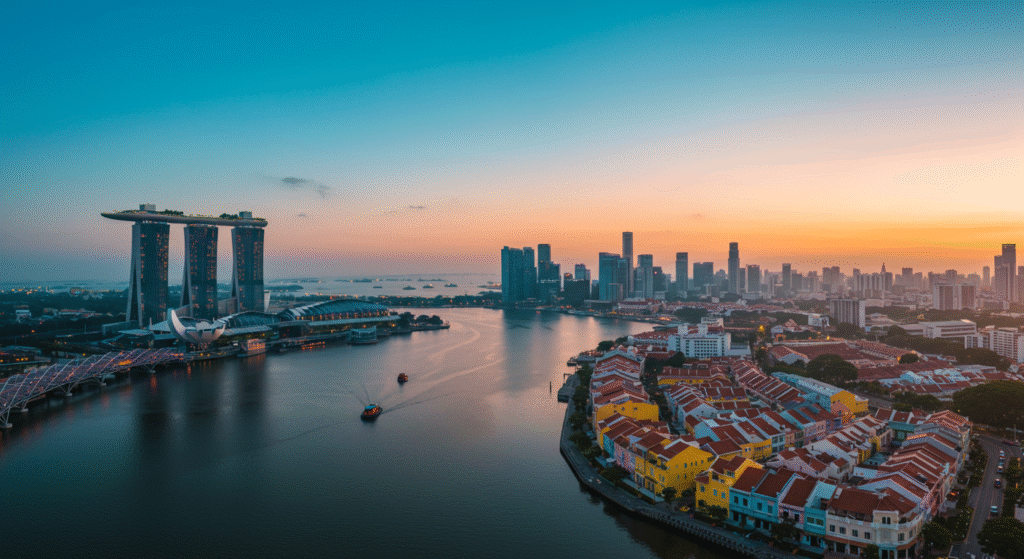
Why does Singapore hit the retina harder than many bigger capitals? The answer begins in 1822 when Sir Stamford Raffles drew his Town Plan, carving ethnic enclaves and civic squares, each soon painted to match its people’s tastes and foreign cargo.
Add two centuries of migration, shipping, mosaic faiths, and climate‑smart tech, and you get streets where mango‑yellow shutters frame wool suits on Robinson Road, while sapphire lasers skim Marina Bay after dusk. In this guide, I zoom into fourteen color themes—each broken into three vivid snapshots—to show how trade pigments, temple lacquer, textile dyes, and LED science converge on one small island.
Expect specific locations, easy design tips, and straight answers to the questions every history‑loving traveler asks: Where do the best pastels hide? Which dish goes fiery orange without artificial dye? How do policy and culture keep the skyline bright yet tasteful? Let’s stroll, stare, and decode Singapore one hue at a time.
Colonial Foundations & Color‑Coded Quarters
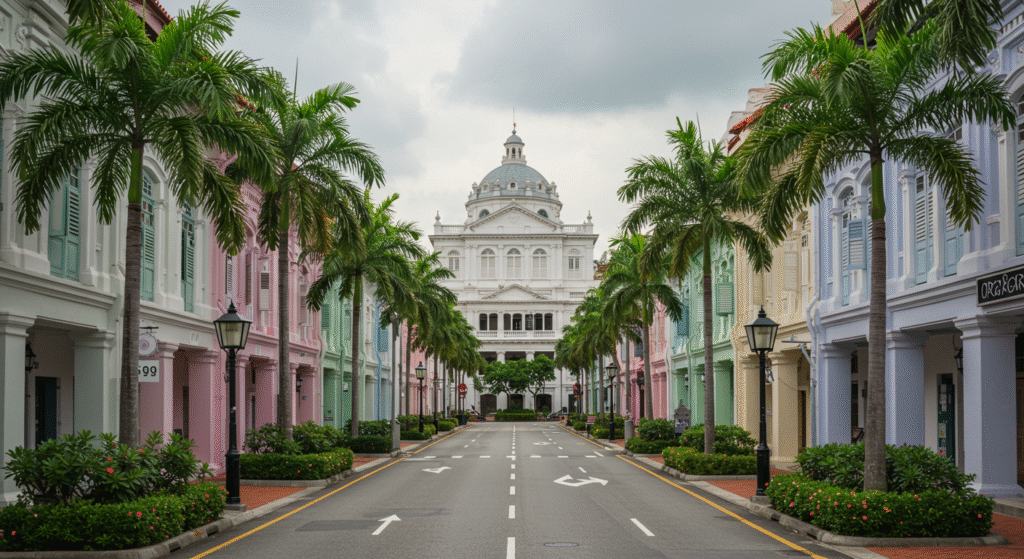
Raffles’ Grid Plan
When Raffles anchored off the Singapore River, he saw a muddy trading spot begging for order. His 1822 blueprint zoned Chinese merchants along South Bridge Road, Malays near Kampong Glam, Indians beside Serangoon River, and Europeans on higher, breezier ground. White stucco on government buildings wasn’t just aesthetic; limewash repelled heat and signaled imperial discipline against riotous jungle green. Today, tourists picnic on the Padang, unaware that the clean canvas of Cricket Club walls once announced, “Empire runs here.”
Pastel Shop‑Houses
Stroll Emerald Hill at sunrise and pastel facades glow like sherbet: lime, peach, lavender—all mixed from slaked‑lime barrels softened by sea air. Immigrant owners flaunted prosperity through color, yet practical minds chose shades that masked mildew and reflected sun. Ornate plaster scrolls outline doors, proving artisans merged Cantonese carving with Dutch floral motifs. Pause for coffee, notice shutters: darker teal highlights frame lighter mint slats, a trick that adds depth to narrow fronts.
Early Trade Pigments
Before container ports, Boat Quay bustled with coolies lugging burlap sacks dyed ochre by Borneo roots, indigo by Gujarati stones, and carmine by Manila cochineal. Warehouse doors copied those cargo colors—part inventory cue, part proud advert. If you spot faint prune stains on granite steps today, you’re seeing ghost streaks of gambier dye, once Singapore’s big export. Designers hunting authentic palettes can sample these earthy tones straight off restored timber beams.
Peranakan Palette
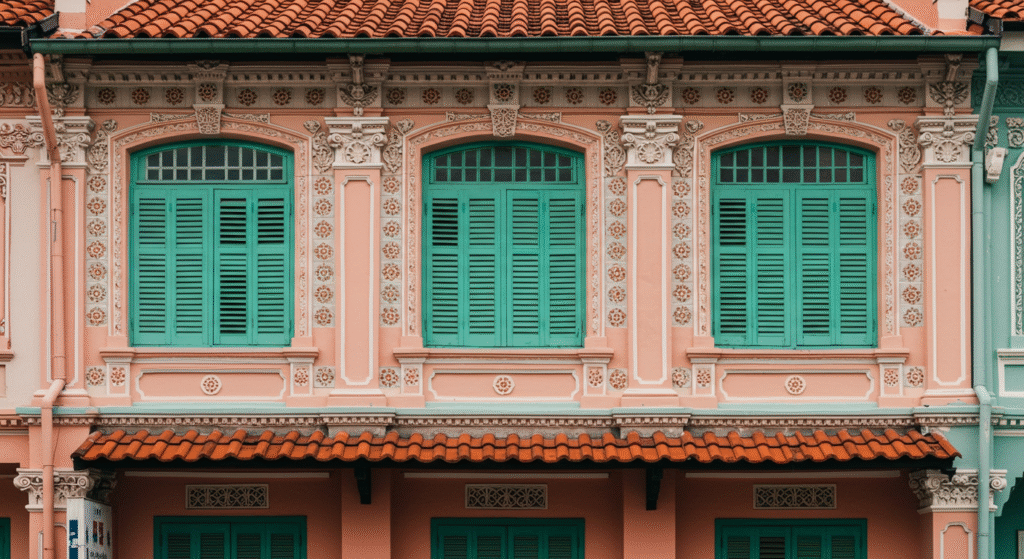
Porcelain Blues & Greens
Step into a Katong terrace kitchen and shelves overflow with nyonya ware: bowls glazed in robin‑egg blue, plates rimmed in sea‑foam green, lids dotted with lotus pink. Straits‑born Chinese adapted Ming dynasty motifs but chose tropical hues that matched papaya skin and lagoon water. Crackle lines on the glaze? They aren’t flaws; they reflect kiln temps and mineral quirks of local clay—perfect talking points for ceramic collectors.
Batik Motifs
Peranakan sarongs use copper stamps to press wax onto cloth, then dip the fabric in coral, mint, and sunflower baths. Artisans often hide family initials in the pattern, so a keen eye spots stories woven between vines and phoenixes. Because natural dyes fade under equatorial sun, wearers rotate darker sarongs at midday and lighter ones for evening strolls, a practice that doubles as heat management and fashion statement.
Terracotta Tiles
Look up at shophouse roofs and you’ll see russet tiles fired on Pulau Ubin in 19th‑century kilns fueled by mangrove wood. Rain and moss tint edges olive, creating gradients perfect for watercolor studies. Those curved tiles also channel monsoon deluges away from timber beams—a color choice that saves architecture as much as it pleases photographers.
Malay Heritage Hues
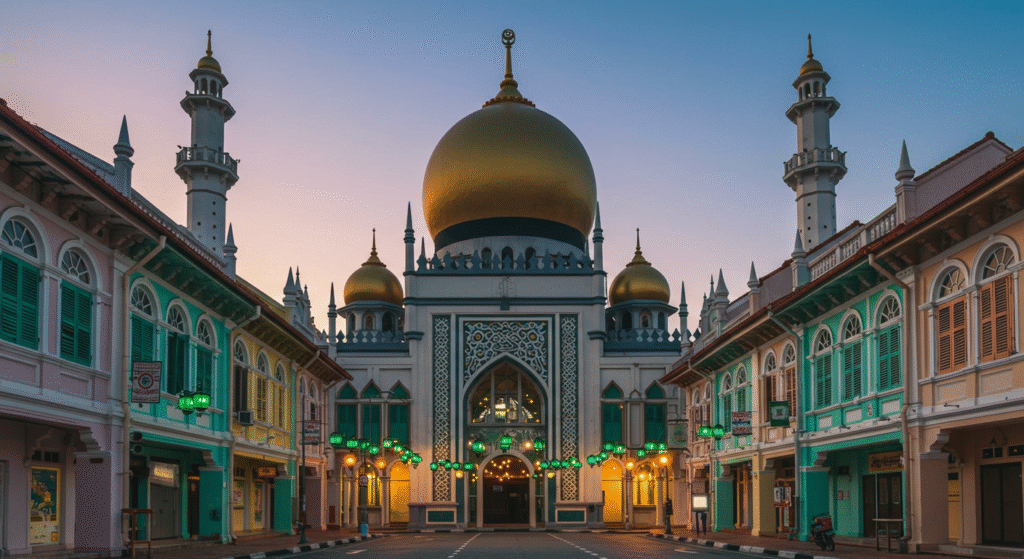
Kampong Glam Facades
Sultan Mosque crowns Arab Street with a golden dome leafed in real bullion, reflecting teal shutters on adjacent spice shops. Mustard walls echo turmeric roots once piled in burlap sacks nearby. Every Friday, pilgrims file beneath this palette, their white robes contrasting the façade, producing striking chiaroscuro for street photographers.
Songket Gold Threads
Malay weavers embed flat gold threads into deep‑jade silk, creating songket sarongs that shimmer like sunlit jungle streams. Looms click steadily, each pass locking metallic glint between matte fibers—a texture that resists both humidity and wrinkles, making songket a prized heirloom for weddings.
Ramadan Lanterns
Come dusk in Bussorah Mall, paper lanterns blush emerald and canary. Craftsmen coat bamboo frames in rice‑glue paper, then brush crescents and stars in calligraphy ink. The lantern queue guides fasting families from mosque prayers to night bazaar snacks, proving color can choreograph foot traffic as smartly as signs.
Chinese Influence in Chinatown
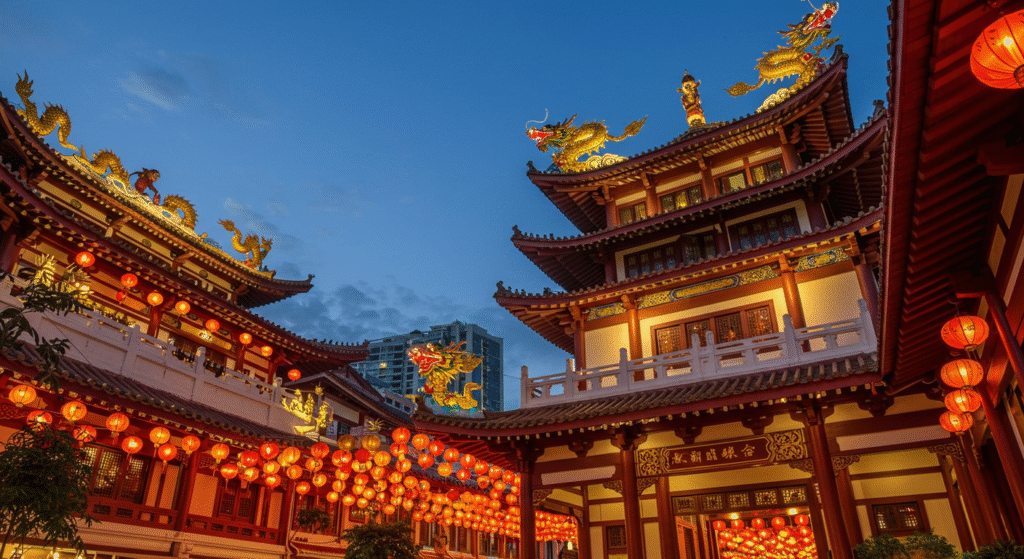
Crimson & Gold Symbolism
Buddha Tooth Relic Temple layers vermilion beams against gold‑leaf dragons, borrowing palace colors from Tang dynasty scrolls. The red wards off bad luck; the gold attracts fortune—simple code understood by every dialect group. Visitors often miss the blue under‑eaves, painted to mimic a protective sky.
Celestial Mural Blues
Pagoda Street’s conserved gable walls feature gods of voyage sailing jade seas under cobalt skies. Restoration teams matched pigments with original mineral powders found on site, so the mural’s blue mirrors lapis lazuli sourced from Afghan traders who docked here a century ago.
Lunar New Year Décor
Each January, volunteers string 10,000 silk lanterns overhead. They dye the silk in pomegranate and cherry gradients, then stencil luck idioms with glitter paint that catches streetlamp glow. The result turns South Bridge Road into a living river of red, drawing photographers who lie on the pavement to capture perfect vanishing‑point shots.
Indian Vibrancy in Little India

Deepavali Light‑Up
Weeks before Deepavali, Serangoon Road erects arches shaped like peacocks bursting with fuchsia LED feathers. Sapphire lotus blooms pulse slowly, guiding shoppers toward flower garland stalls. City engineers program the lights to dim between two and four a.m. to save energy while leaving faint glow for safety—responsible dazzle at its best.
Saree Silk Spectrum
Inside Tekka Centre, bolts of amethyst, citrine, and ruby silk drape over stainless tables. Shopkeepers snap the cloth, letting weft threads catch ceiling fluorescents in rhythmic waves. A good bargaining tip? Compliment the shade’s “jalan jalan” dance—the phrase means wandering light—before naming your price.
Rangoli Door Art
During harvest festivals, families grind rice, spinach, and turmeric into powders, then sift them through clenched fingers to build rangoli patterns at their thresholds. Turquoise fish swirl beside tangerine suns, inviting Lakshmi into the home. Rain often smudges the art within hours, yet neighbors remember the design, proving transience can still wield community power.
Modern Skyline Chromatics
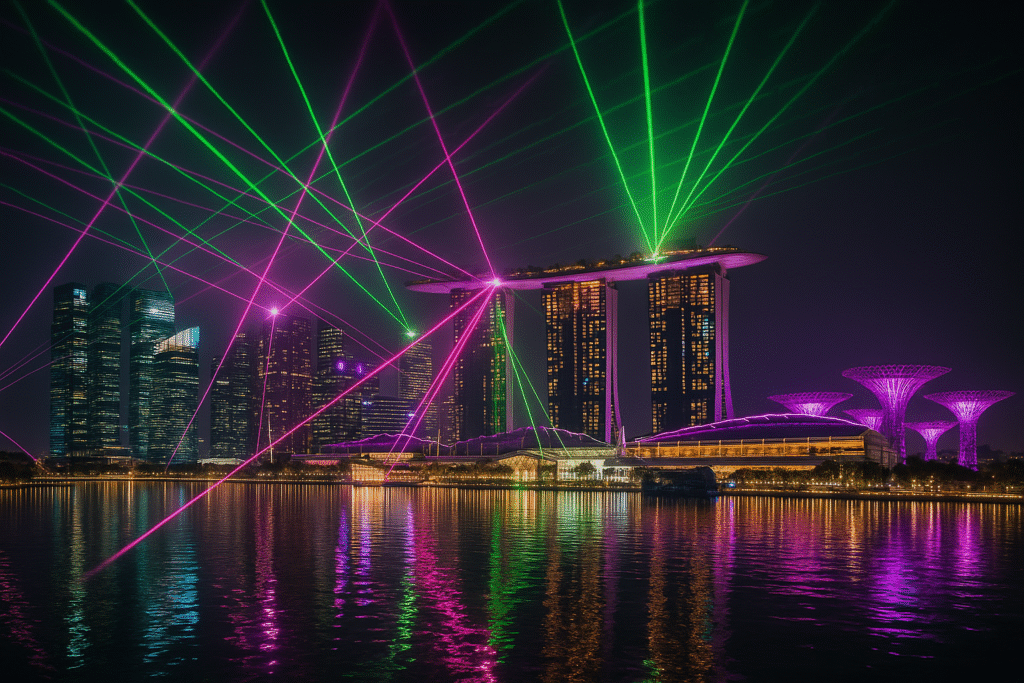
Marina Bay Sands Light Show
At 8 p.m. sharp, lasers leap from the hotel’s “surfboard” deck, tracing emerald zigzags across fifty‑story glass. Designers timed reflections so that business‑district windows flash magenta echoes, doubling color without extra bulbs—a clever nod to energy limits. Couples dining on the promenade gain free foreground glitter for proposal photos.
Supertree Grove Glow
Gardens by the Bay stacks vertical gardens on steel trunks, each trunk sheathed in orchids, bromeliads, and ferns. Daylight paints a thousand greens, but at dusk, violet LEDs pulse to symphonic music, turning flora into futuristic stained glass. The lighting script adapts monthly, so repeat visitors always meet new hues.
Skybridge Sunsets
At Pinnacle@Duxton’s 50th‑floor bridge, warm orange sunsets bleed into concrete gray towers, softening brutalist edges. Residents run evening laps, their neon sports gear streaking the scene with pop colors—a living proof that active design can humanize high‑density housing.
Green Nation Vision
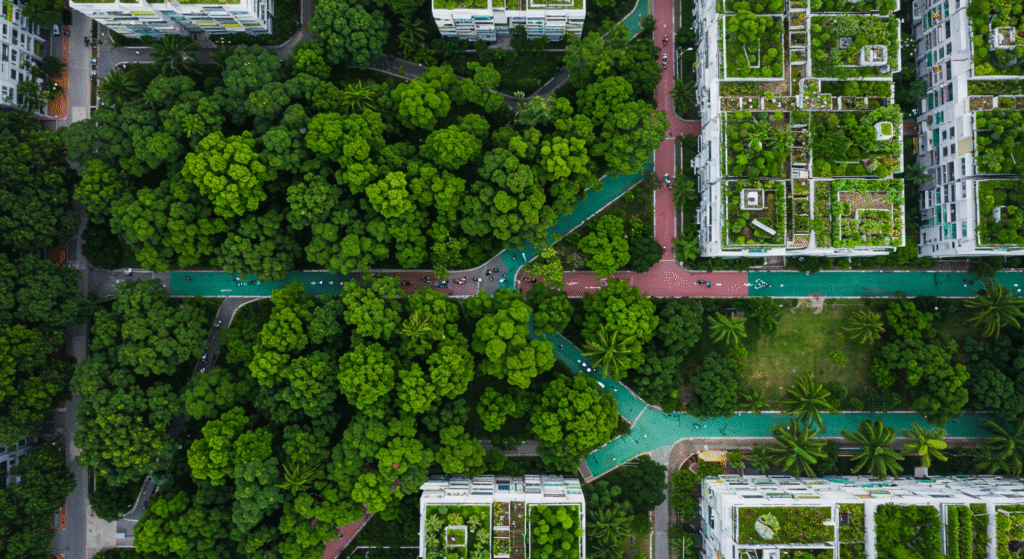
Park Connector Network
A web of cycling paths curls through housing estates, stitching jade, lime, and forest canopies into one contiguous ribbon. Urban planners planted quick‑sprouting golden penda trees so riders experience bursts of butter‑yellow in six months, not years.
Rooftop Farms
Above Orchard Road malls, scarlet chili rows grow beside basil quilts. Cross‑ventilated walkways draw shoppers upward for skyline selfies, merging agriculture with retail footfall. The basil scent drifts down escalator shafts, a subtle marketing lure.
Urban Biodiversity Corridors
Along Kallang Basin, reeds sway olive and chartreuse, sheltering kingfisher‑blue birds. Engineers shaped flood‑control embankments to double as wetlands, proving that climate resilience can paint pleasing color gradients across an otherwise gray canal.
Hawker Culture Colors

Laksa Tangerine Broth
Katong laksa’s coconut curry shines pumpkin orange under fluorescent stall lights. Chili oil beads float like ruby marbles, while green laksa leaves punctuate the soup, offering photographers a ready‑made complementary palette. Locals slurp with stubby spoons, adding motion blur to food shots.
Chendol Jade Swirls
Shaved ice mounds glisten snow‑white until pandan noodles and gula melaka syrup turn the bowl into layered jade and espresso. Vendors shave palm sugar blocks by hand, releasing caramel aromas that hitchhike on humid air, pulling passers‑by from three stalls away.
Kopitiam Mosaic Tiles
Many 1950s coffee shops kept mint‑and‑black checker floors of clay tiles fired in Johor kilns. Decades of spilled kopi O give the mint squares a faint latte patina, creating accidental ombré that interior designers now replicate on purpose.
Festivals in Technicolor
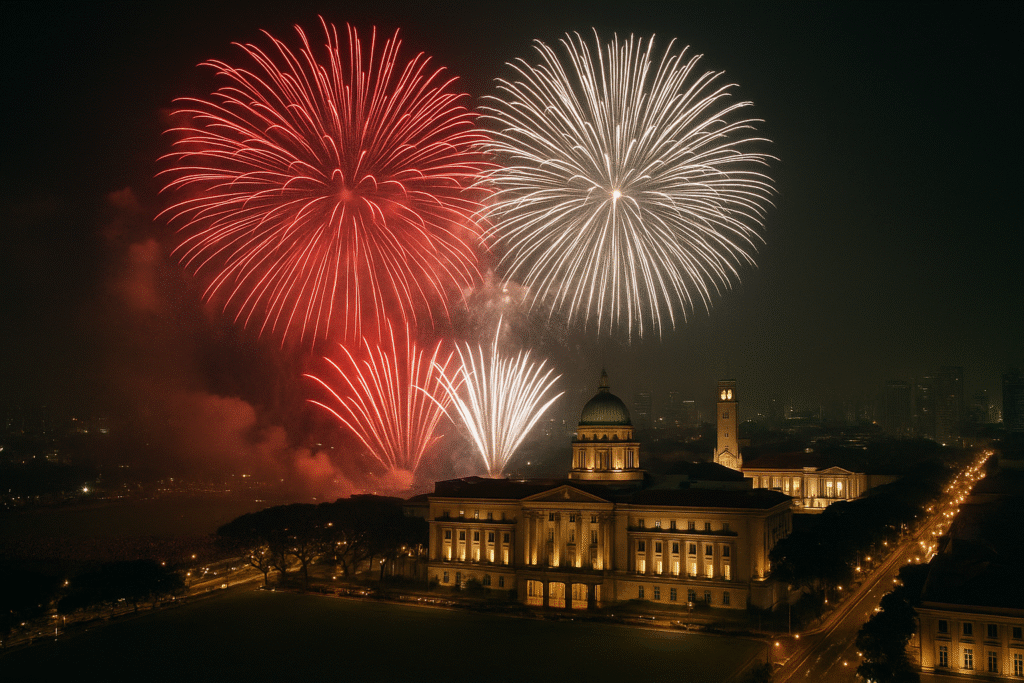
National Day Reds
On August 9, planes streak the sky with trails dyed scarlet and snow‑white, matching flags waved by spectators packed on the Padang. Fireworks bloom hibiscus‑red above colonial domes, merging past and present power symbols in one twelve‑minute spectacle.
Thaipusam Offerings
Devotees pierce skin with silver kavadis polished to mirror finish; turmeric‑yellow garlands drape across shoulders, highlighting crimson beads of kumkum powder on foreheads. The procession moves from Serangoon Road to Tank Road, turning city asphalt into a slow‑motion river of gold and silver light.
Hari Raya Green Banners
A week before Eid, Geylang Serai night bazaar lifts emerald cloth banners inked in white Arabic script. Food stalls echo the green with pandan waffles and avocado milkshakes, reinforcing harmony between décor and cuisine.
Architectural Conservation
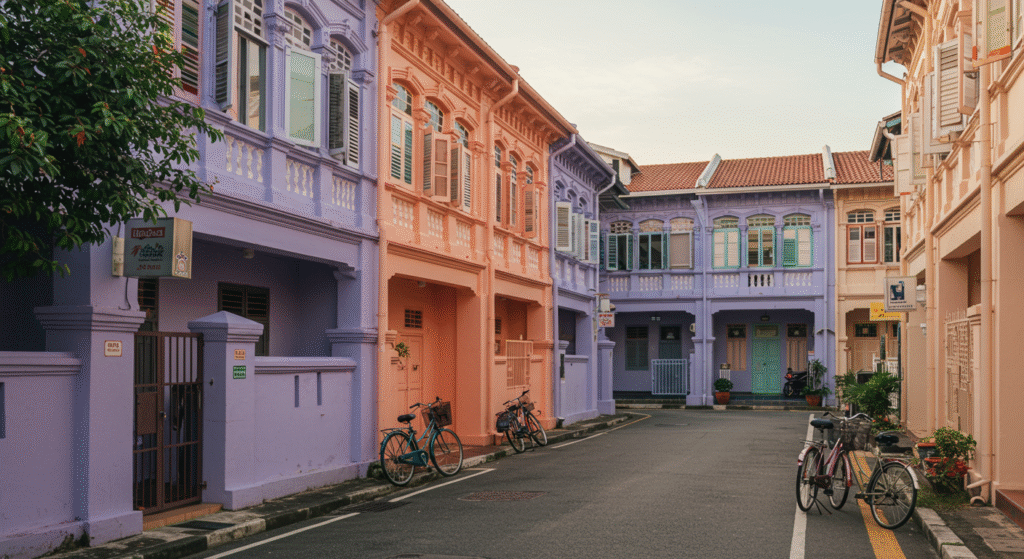
Restored Shop‑House Pastels
Government grants require breathable lime paints, so owners pick peach, mint, or lavender that won’t trap moisture. Restoration architects photograph original flakes, then match shades using modern mineral tints, proving preservation can still breathe creativity.
Art Deco Lines
Tiong Bahru flats sport cream bands edged with sage. Curved balconies throw shadows that shift from espresso at dawn to beige by noon, offering resident photographers a daily time‑lapse in grayscale.
Heritage Board Guidelines
Officials distribute fan‑decks of sanctioned hues—neither too neon nor too dull. Applicants propose tweaks; committees weigh context. The result is streets that feel diverse yet harmonious, not sterile Disneyland copies.
Art Scene & Murals
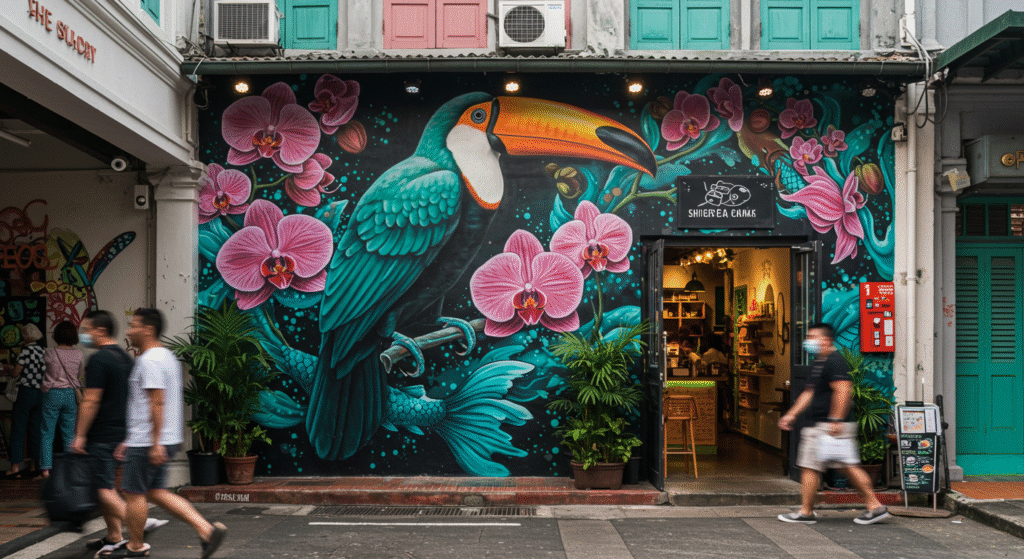
Haji Lane Street Art
Once a blank alley, Haji Lane now bursts with toucans, orchids, and cosmic koi spray‑painted in neon teal and magenta. Artists layer UV‑reactive paint, so murals glow under bar lights, lengthening visitor hours without extra marketing spend.
Gillman Barracks Galleries
White cubes inside colonial barracks host canvases where Southeast Asian painters test saffron gradients against charcoal lines. Gallery LEDs run at 4000 K, a warm setting that flatters earthy hues and invites longer visitor dwell times.
Singapore Art Week
Each January, projectors map animated cyan waves onto the National Gallery façade. The show references monsoon charts from 19th‑century shipping logs, reminding watchers that data can inspire art when you color‑code it cleverly.
Lighting Technology & Smart City
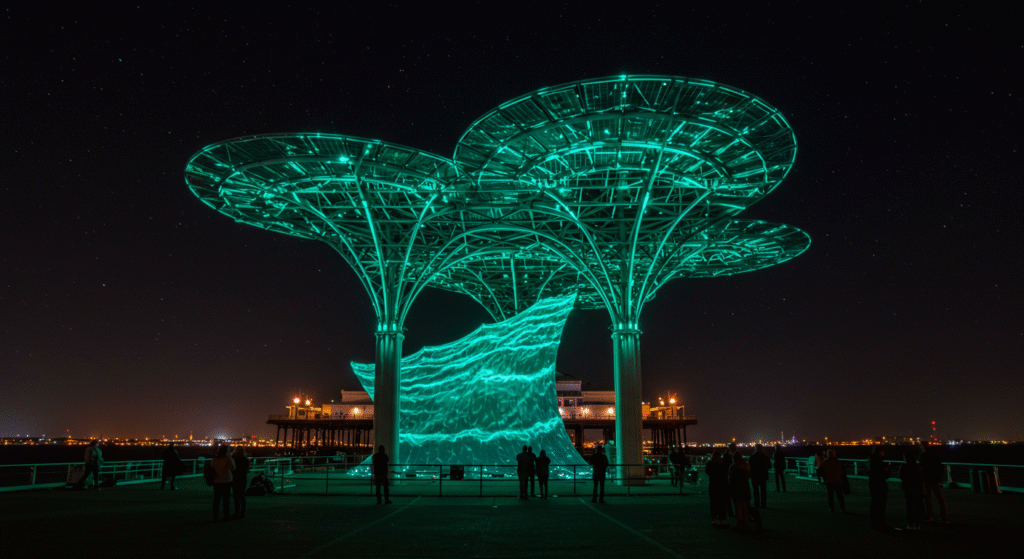
LED Color Policy
The Urban Redevelopment Authority bans garish billboards yet permits adaptive skyline lighting. Buildings must submit mock‑ups proving color cycles won’t clash with neighbors—a rare case of city code functioning like a giant mood board.
iLight Festival
Solar‑powered sculptures bathe Clifford Pier in turquoise ripples. Motion sensors dim LEDs when foot traffic dips, saving watts while preserving the watery illusion. Festival designers share energy use dashboards in real time, turning spectators into sustainability ambassadors.
Sustainable Illumination
Orchard Road swaps to warm‑white bulbs after midnight, cutting glare and electricity use by 30 percent. The cozier glow also nudges late‑night shoppers toward cafés, boosting F&B revenue—proof that eco moves can pay dividends.
Maritime Tones
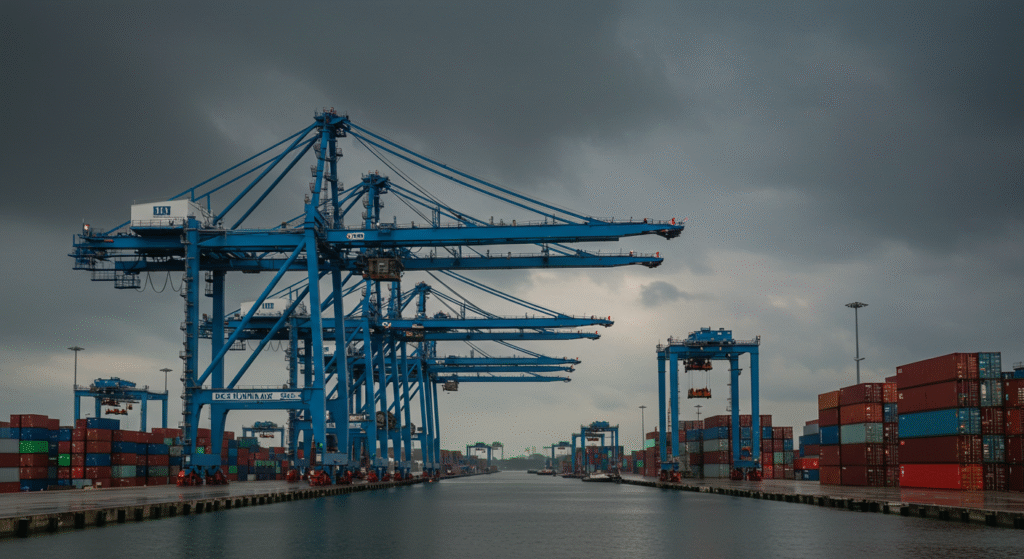
Singapore River Warehouses
Clarke Quay’s ox‑blood shutters got their hue from iron oxide in 19th‑century boat paint, chosen for corrosion resistance. Lantern glow polishes the red to wine shades, creating depth photographs struggle to capture without HDR bracketing.
Dockyard Crane Blues
Jurong Port’s cadet‑blue cranes contrast vermilion containers stacked like giant Lego bricks. Port authority picked the blue to stand out against gray monsoon skies, a safety choice that doubles as industrial chic.
Sentosa Sea Greens
Near Fort Siloso, seawater shifts bottle‑green by noon, then midnight‑ink after storms. Cable‑car cabins, painted cherry red, skim the surface, slicing intense complementary streaks through aerial photos.
Future Color Trends
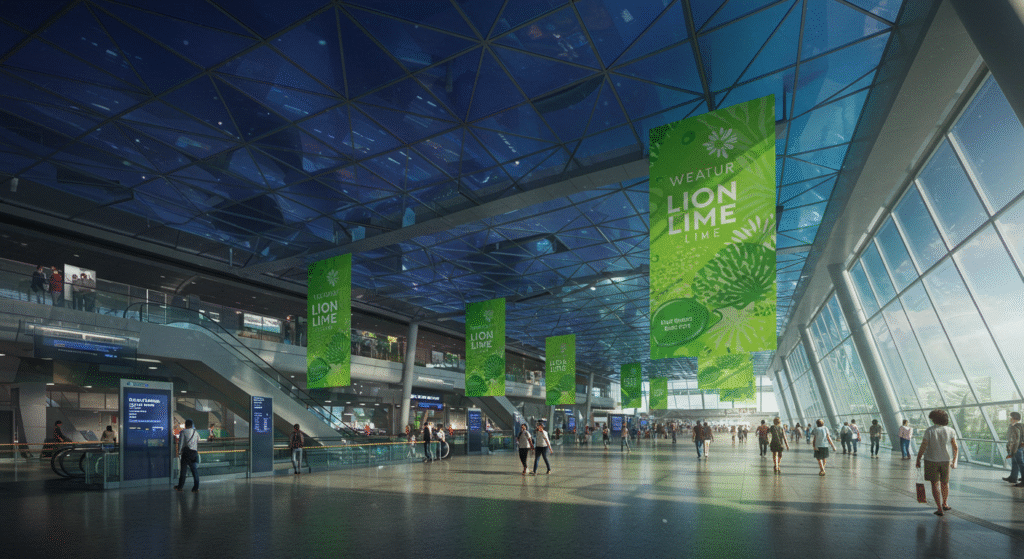
Pantone Collaborations
DesignSingapore Council and Pantone co‑release “Lion City Lime,” a zesty green predicted to headline local startup branding decks. The hue riffs on the island’s eco ambitions and tropical fruit stalls, grounding future tech in sensory memory.
Smart Materials
Changi Terminal 5 plans glass that darkens to sapphire under harsh sun, cutting heat and glare while delighting jet‑lagged passengers. Architects borrowed the idea from butterfly wings, proving biomimicry’s role in tomorrow’s palettes.
Sustainable Pigments
Local biotech labs test algae‑based dyes in emerald and lapis. Early samples resist UV fade better than petrochemical cousins, hinting that tomorrow’s color stories may sprout in bioreactors rather than oil drums.
Summary Table
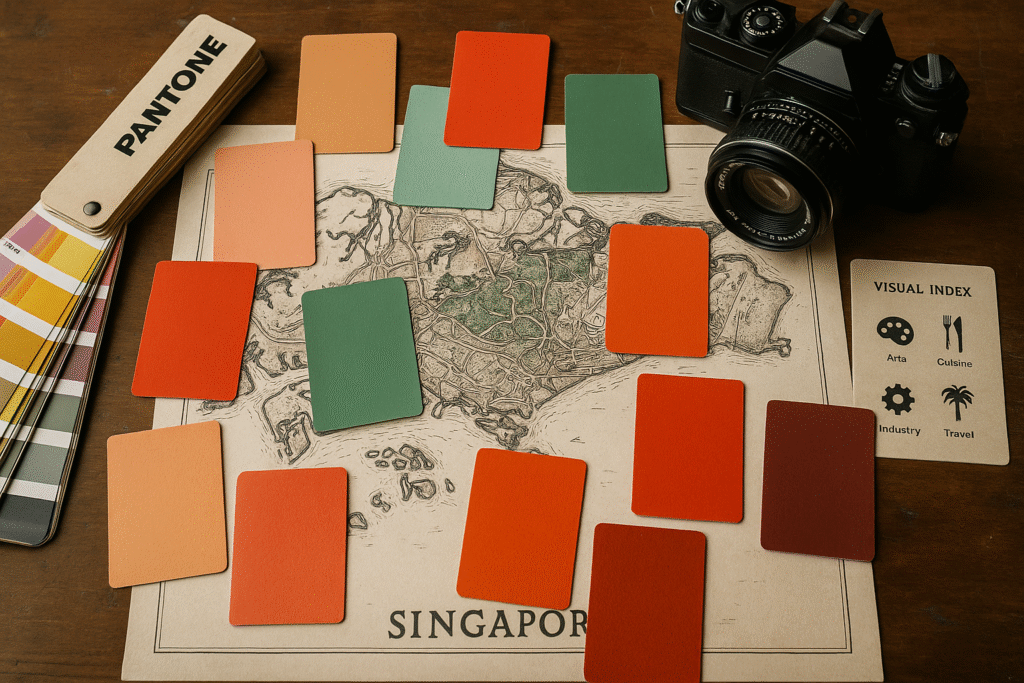
| Theme | Stand‑Out Hues | Where to Spot Them | Cultural Root | Design Tip |
|---|---|---|---|---|
| Colonial Quarters | White, pastel lime | Civic District | 19th‑cent. Town Plan | Frame bold trim with neutral body paint |
| Peranakan | Turquoise, coral | Katong shop‑houses | Straits Chinese craft | Mix complementary tiles for lively floors |
| Malay Heritage | Gold, teal | Kampong Glam | Islamic motifs | Use gold accents sparingly for luxury |
| Chinatown | Vermilion, cobalt | Pagoda Street | Chinese symbolism | Red‑gold combo signals luck in signage |
| Little India | Fuchsia, amethyst | Serangoon Road | South Asian textiles | Saturated hues thrive in strong daylight |
| Modern Skyline | Magenta laser, orchid LED | Marina Bay | Smart‑city tech | Sync light shows to glass reflections |
| Green Nation | Jade canopy | Park connectors | Eco urbanism | Contrast foliage against concrete gray |
| Hawker Fare | Laksa orange | Food centres | Fusion cuisine | Feature natural food color in branding |
| Festivals | Ruby, emerald | Padang, Geylang | Multi‑faith calendar | Rotate palette seasonally in campaigns |
| Conservation | Peach, lavender | Tiong Bahru | Heritage rules | Pastels soften dense streetscapes |
| Art Murals | Neon teal | Haji Lane | Youth culture | UV paint extends mural life at night |
| Smart Lighting | Turquoise solar glow | iLight | Sustainability push | Low‑energy LEDs allow vivid nights |
| Maritime | Cadet‑blue cranes | Jurong Port | Shipping heritage | Accent industrial shots with cyan filters |
| Future Trends | Lime algae dye | Design fairs | R&D focus | Eco pigments appeal to green consumers |
Conclusion

Pause on any corner in Singapore and color speaks in layered tongues. It narrates empire, spice routes, clan feasts, and tomorrow’s carbon‑lite blueprints—all in a glance.
When you photograph pastel shutters in Katong, sip pumpkin‑orange laksa, or track magenta lasers across Marina Bay glass, you’re reading a living manuscript of pigment and light.
Use this guide to time your walks, tune your camera white balance, or draft a brand palette that borrows Lion City flair without cliché. In doing so, you’ll see color not as decoration but as the pulse of a city forever mixing past memory with future glow.
FAQ
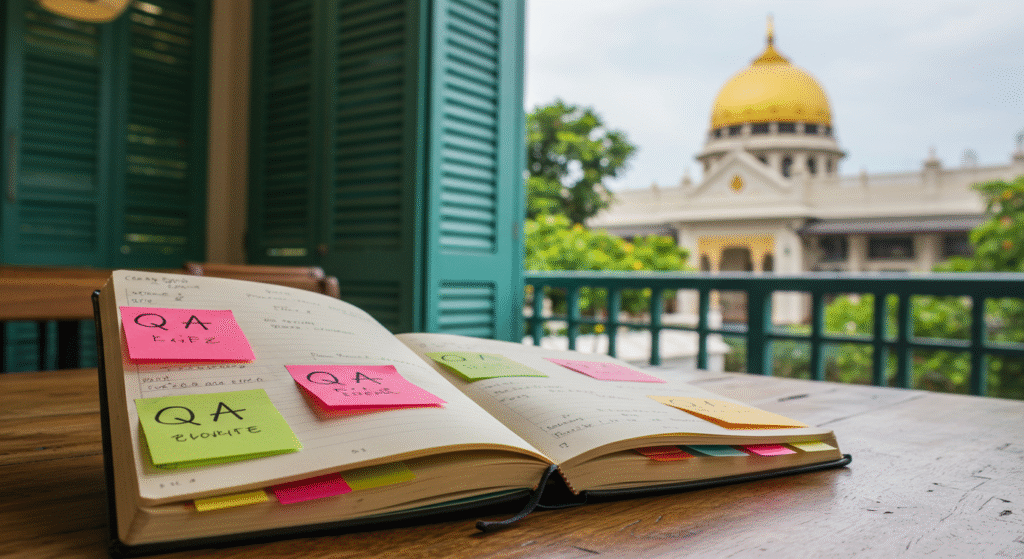
Q: When should I visit to capture Singapore’s most vibrant festivals?
A: Aim for July through November. You’ll snag National Day’s crimson burst (Aug 9), Deepavali’s sapphire arches (date shifts yearly), Mid‑Autumn’s cherry lantern river in September, and Geylang’s emerald Hari Raya night bazaar in October. Each event wraps the city in a distinct, photo‑friendly palette.
Q: Where can photographers find untouched heritage pastels without tourist crowds?
A: Hit Katong’s side lanes—Koon Seng, Joo Chiat—just after dawn on weekdays. Soft gold light flatters mint and peach facades, while delivery vans haven’t yet clogged streets. Bring a 35 mm lens to capture full façades without crossing the narrow road.
Q: Does Singapore regulate building paint choices?
A: Yes. In gazetted heritage zones, owners submit shade swatches to the Urban Redevelopment Authority. The board checks that colors echo period pigments and neighbor harmony. Outside those zones, guidelines loosen, yet LED displays still require light‑spill modeling.
Q: Which hawker dishes showcase bold natural colors safe for social posts?
A: Katong laksa offers orange broth from chili and shrimp shells, chendol presents pandan‑jade noodles on snow ice, and bandung rose milk shows candy pink. All rely on fresh ingredients, so no artificial dyes upset health‑conscious audiences.
Q: Are the nightly light shows sustainable or just flashy?
A: Major installations use LEDs drawing a fraction of halogen wattage. Events like iLight layer solar panels and motion sensors, cutting power when crowds thin. Organizers publish energy metrics, turning spectacle into a teaching moment for green tech lovers.
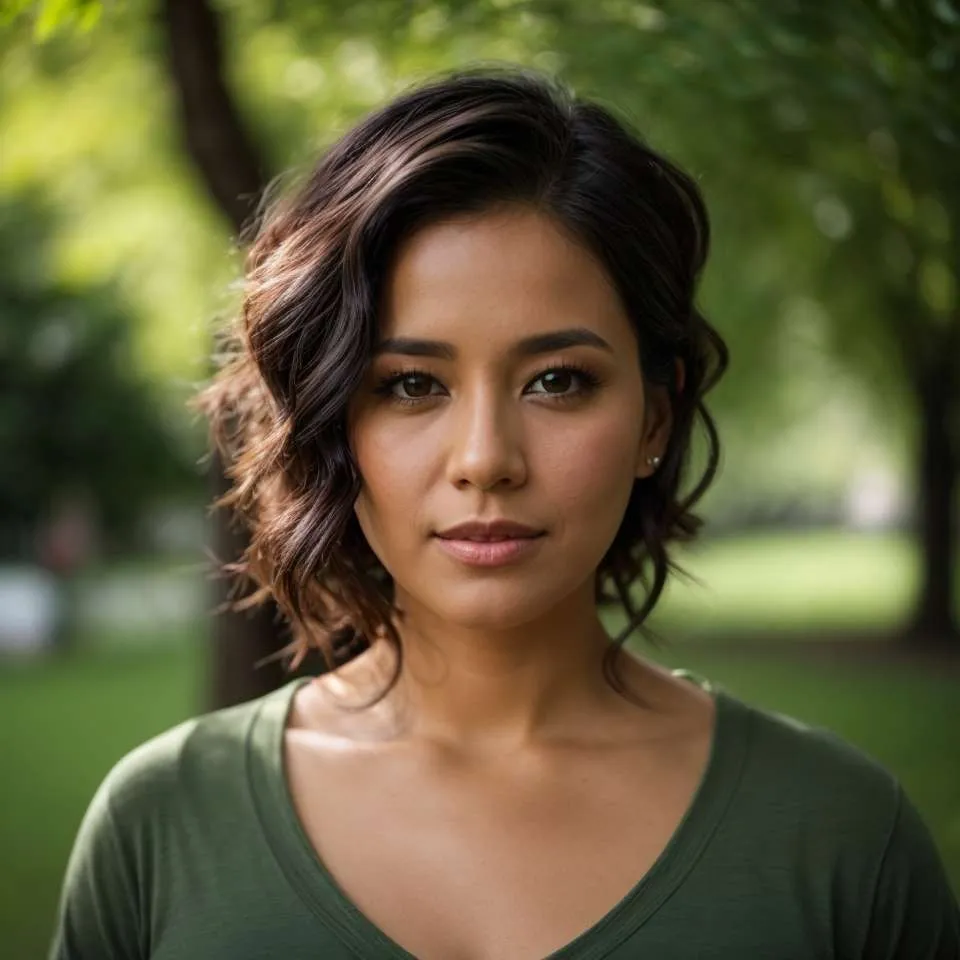
Joanna Perez, with a degree in Creative Writing, excels in recommending distinctive clothing color mixes and trends that deeply connect with readers. She simplifies the often daunting task of color selection, making fashion decisions more personalized and impactful. Her passion for vibrant color palettes and the stories they tell makes her an indispensable voice in the fashion community.
Reviewed By: Marcella Raskin and Anna West
Edited By: Lenny Terra
Fact Checked By: Sam Goldman
Photos Taken or Curated By: Matthew Mansour
